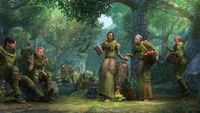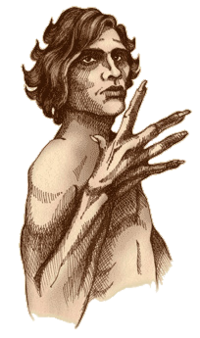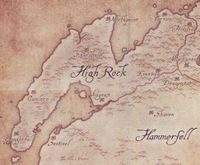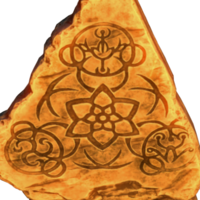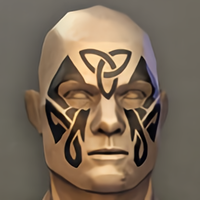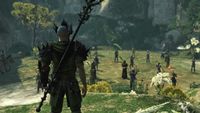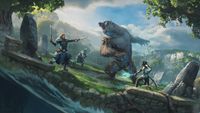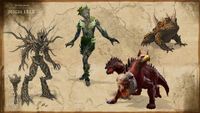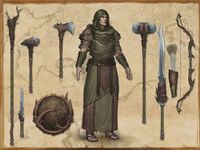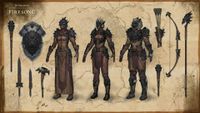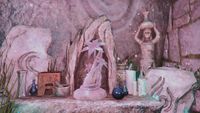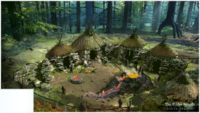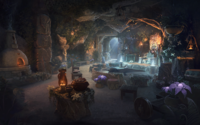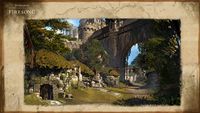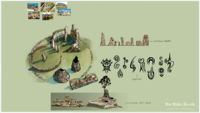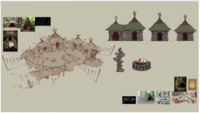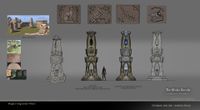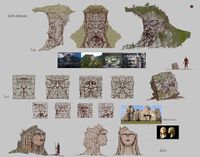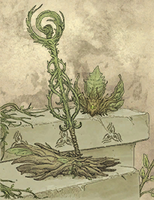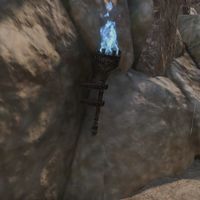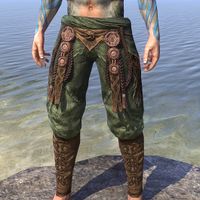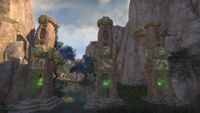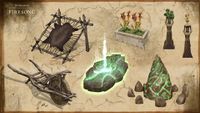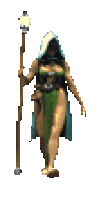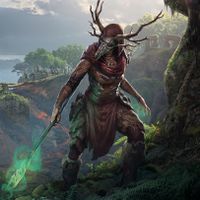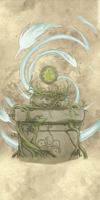Lore:Druids
Druids (also known as vinebeards)[1] are children of the land whose kind have their origins in ancient High Rock.[2][3] They are practitioners of Y'ffre's True Way (also known as Druidism),[4] in which one is to lead a life connecting with, valuing, and stewarding the growth of the natural world[5][6] referred to as the Green.[7] The eponymous god takes the forefront of their faith, with some reverence also being shown to the stars.[8] The True Way is a promise made to the "groves, to the seas, to the sky",[7] and under the Oak's Promise, druids are to "stand strong, stay true, and shelter all".[9] Druids serve in accordance to Y'ffre's will in roles such as priests,[2] arbiters,[10] teachers, healers,[6] and soothsayers.[7] Druids have little interest in the quarrels of monarchies, often leading many to believe that they are pacifists. However, as champions of nature, they are not afraid to defend their ancient sites from the cruelty of civilization, as violence and death are natural.[2][5]
Y'ffre and his Earthbones sacrificed themselves during the Dawn Era to create the Green, an act which bound Nirn to the laws of nature.[11][12][13][6] Their voices are sought by druids so they may best be their advocate, and to ensure a life guided by natural principles and the willfulness of nature.[6] Druidic spellcraft (which differs from the arcane) is said to be the first truly Breton creation,[14] and its practitioners utilize the wellspring of primordial energy the Earthbones left behind, which flows via lines through the ground.[15][16] Junctions where this resource intersects are known as "bonelines", places where druidic spells exhibit strange properties, and where prayers carry deeper emphasis.[17] It can be harnessed by druids to overcome their physical limitations,[15] shapeshift into various animals,[7] terraform the environment around them,[18] or even invoke natural disasters to consume their foes.[19] Druids are also known animists[20] who can call upon nature spirits to aid them.[14]
Overview[edit]
- "The story of the druids is the story of the Bretons. And of the wyrd. At least to a point. You ask what we as druids believe, and I say that what we believe comes from where we were born. And both the wyrd and the druids—indeed, all Bretons—rocked in the same cradle." —Wyrd and Druid
Druids are defined by many dichotomies, and prime among these is their acknowledgement of their Breton heritage of hailing from both Men and Mer.[15] The first vinebeards are referred to as the Druids of Galen by retroactive nomenclature, and they were the Nedes of High Rock[21] (or proto-Bretons)[UOL 1][7] that intermingled with the Aldmer[22] (primarily Clan Direnni) for centuries during the Merethic Era.[23][21] From this union, the Bretons (then called "Manmer" and "Half-Elves")[24][25] were conceived as unwanted half-breeds,[14] rejected by their Direnni parents that considered them sub-Mer.[14][8] The Druids of Galen led this newly emerged race,[UOL 2] and Manmer were elevated in Nedic society, where they thrived.[23][24] Although the term Manmer is archaic, modern druids embrace it.[20][8] Bretons have a natural affinity for environmental manipulation,[26] which druids believe should be utilized to enhance or perfect nature, reshaping it just as Y'ffre once did.[20][8]
Druids as a distinct identity emerged shortly after the Breton race first came into existence.[8][14] This was further warranted when the Wyrd diverged from the True Way in a religious schism, ultimately driven away by what they called the "excesses of the Elves".[8] In druidic belief, Bretons[8] (and others) were not meant to separate themselves from nature, as one can rejuvenate and enjoy Y'ffre's bounty through it.[27][2] While ancient druids revered nature, they were not keen to isolate themselves and worship the untamed wilds.[8][5] Therein lies the primary difference in culture between druids and the Wyrd: the Wyrd abandoned civilization in favor of living in the wilds,[8] and believe that they are nature itself: the forest, the plants and beasts within it, and even the weather.[28][8] In contrast, the druids accepted what they interpreted as their "proper place" as people, and embraced the idea that civilization can coexist alongside nature.[8][5][2][29] The Druids of Galen and the Wyrd disapproved of each other's lifestyles: the druids found the ways of the Wyrd unsavory, and the Wyrd thought the druids as "barons in ivy robes" that were no better than city-dwellers.[29]
Druids would much later practice self-isolation to varying degrees,[2][30][31] as a response to the historical encroachments and heartless deprivations that would await them.[8][5] The Druids of Galen wanted self-governance without the Direnni's interference, as well as freedom from the religious persecution such as that from the Alessian Order,[8][5] but ultimately, they were driven into exile to the Systres.[2][21] The Druids of Galen were a united entity[29] led by a line of ancient kings,[5] and they were already Bretons themselves by the time the last Druid King led them on their exodus to find a new home.[21] When they arrived on the Systres, they disbanded and reorganized themselves into fellowships referred to as druidic circles. Each circle interprets Y'ffre's will differently, while druids within the same fellowship share the same traditions and objectives.[2][8][UOL 3] Xenophobia among the druidic circles varies in the modern day, with the Stonelore being welcoming and taking willing converts, and the Eldertide and Firesong being hostile.[2][30] Druids in turn are treated as convenient scapegoats,[32] and some devotees of the Divines may trivialize their religion as some woodland cult.[33]
Disambiguation[edit]
Druidism's practitioners are not to be confused with others that fall under the nature magic user archetype, such as Bosmeri Greenspeakers and Spinners, Reachfolk Shamans, and the Wardens.[21]
The True Way is not the Green Pact,[34] a bargain Y'ffre struck with the Bosmer.[12] The two differ in that Wood Elves have many restrictions that druids do not have, such as them not being allowed to eat plant life, and not being allowed to shapeshift except through the ritual known as the Wild Hunt.[35] In return for following the Green Pact, Bosmer can invoke the Wild Hunt in dire times, which irreversibly transforms the participants into a horde of feral and all-consuming eldritch beasts, which go on to lay waste to the enemies of the Bosmer, and then itself.[36][37]
Certain aspects of the True Way share similarities with the religious practices of the Reachmen, but they differ in implementation.[38][39] Reachfolk are known to build relationships with spirits big and small, but they lean more on negotiation rather than on reverence.[40] Reachfolk also primarily worship the Daedric Princes as the "Great Spirits",[41] and their nature magic comes from sources such as Hagravens,[42] Orcs,[43] or the Daedric Princes.[44]
Druids are speculated to be related to Wardens, although moreso in the heart rather than in the mind. Druids use the True Way to guide their magics, while Wardens feel Nirn calling to them in their gut.[21]
Though the True Way is Breton in origin,[14] outsiders such as those of other races have become druids, in particular thanks to the Stonelore Circle, who are not hostile to people of other faiths, nor would they force their beliefs on others.[45][2][30] One Argonian became a druid of the Stonelore because they saw Y'ffre as a shepherd of Sithis's will, as change adheres to natural laws.[30] Another example is a Bosmer of the Stonelore, who followed both Druidism and their race's Green Pact at the same time.[34] The other two major druidic circles however do not see outsiders as druids.[34][30][46]
History[edit]
The Proto-Bretons of High Rock[edit]
Druidic history is primarily oral history,[7] for many records have been lost, and druidkind has been nearly wiped out several times throughout history.[47][48] Naturally, the origin of Druidism is steeped in myth. Some say a Nedic figure known as Druid Queen Galen was one of the first to channel the songs of Y'ffre, and became the first Archdruid. Others believe the True Way emerged from an island named Galen in the middle of a lake, where the Breton's forebears heard Y'ffre's heart beating; yet in another, Galen was the name of a spirit that wandered into a proto-Breton settlement and taught them of the Green.[7] Y'ffre's name itself was not known until the "daughters and sons … [of] Anuiel" taught it to the Breton's forebears.[8] Regardless of their origin, it is agreed that the True Way was born in High Rock.[3]
Whether Man or Mer came to High Rock first is debated in scholarly circles. Some believe that Nedic civilization and their Druid King were already established in the province when the Aldmer arrived,[23] while others claim that the Nedes arrived in High Rock afterwards, and encountered the elves gradually with a variety of reactions and outcomes.[49][50][UOL 4] There is evidence of human settlements in High Rock dating back at least a thousand years before recorded history.[51] Archaeological excavations have dated the ruins of Nedic habitation to as early as ME 1000, predating Ysgramor by centuries.[49] The Aldmer that settled High Rock did so sparsely and in very specific locations, the most successful being Clan Direnni,[50] who came to the province from the Summerset Isles in the Middle Merethic Era.[52][53]
The Direnni didn't enslave the Nedes outright as the Ayleids of Cyrodiil did; instead, they ruled them as a noble caste. The elves established a system of feudal vassalage over their new subjects and took Nedic concubines.[24][53] They inevitably interbred with their human subjects, producing Half-Elven children (also known as Manmer).[24][25]
Druids Arise as a Distinct Identity[edit]
The Druids of Galen led the new race when it first emerged,[UOL 2] as children begat from Elf-Nede relations were considered sub-Mer and not accepted by their Direnni parents. Instead, they were given privileged positions among the Nedes, which eventually lead to a recognizable mixed-blood human caste dubbed "Bretons", from the Ehlnofex "beratu", meaning "half".[23][24] These Bretons were only allowed to marry humans, and over time, the Breton's human features became more prominent than their elven traits.[24]
Druid as a distinct identity was created shortly after the Bretons first came into existence.[8][14] This was justified further when sisterhoods repulsed by the Direnni became the Wyrd when they retreated into isolation, and embraced the more primal aspects of nature.[8] The Direnni, seeking to tame nature, forged a pact with the Earthbones to protect their settlements from the encroachment of the wilds.[54] Ancient druids were considered "Meriphilic",[18] but eventually their tolerance for outside influence would wane, and they would find themselves fighting for the soul of High Rock.[2] The Druids of Galen believed civilization should live alongside nature, not tame it,[2] and they attempted to hold onto their power with fearsome magic, either behind the scenes or directly.[55]
First Era[edit]
Ultimately, the Druids of Galen became the split from Bretondom around 1E 330, when two major powers vied for control of High Rock. The Direnni Hegemony did not take kindly to the attempts for druidic governance of the province, and the Alessian Order persecuted them as they deviated from their religion.[8] Following the guidance of Y'ffre's visions[3] (or a song, or an Elder Scroll),[18] Druid King Kasorayn led somewhere between an estimated few thousand to a million druids on an exodus to the Systres,[3][18] and a few remained on the mainland.[2] It is said that for their exodus, Kasorayn received a vision from Y'ffre which taught him how to sing the plants and trees of High Rock into seaworthy vessels, and he in turn taught the druids how to do so.[3]
Post-Circle Druids[edit]
The surviving vessels eventually made it to the Systres,[3] but sources conflict on whether the island of Galen or Y'ffelon was the site of the Druids of Galen's first landing.[48][18] Regardless, the Draoife terraformed Y'ffelon from a barren volcanic island into a lush and verdant volcanic paradise,[18] and then the druids swiftly expanded across the rest of the archipelago,[56] sprouting life where it was once barren.[18] The dissolution of the Druids of Galen was brought about with the event known as the "three mornings of sail", when priest-navigators set out to sea on enchanted vessels outside the archipelago. Their outside experiences and their interactions with different races resulted in three sects developing, each with their own interpretation of Y'ffre's will; the Stonelore, Eldertide, and Firesong Circles.[2][18] Other sources claim Kasorayn caused the druidic schism when he foresaw a coming disaster in a prophecy now known as the Dream of Kasorayn.[47]
Before the Druids of Galen ventured into the Systres, Druid King Kasorayn visited both the Beldama[57] and Glenmoril Wyrd Covens in preparation.[47] Together, they nurtured the nature spirit known as Frii from the dream of the Green.[58][59] Frii was the Sower, the entity that was to create sacred seeds which were to contain the regalia of the Druid King, royal symbols to be passed onto the future druidic circles.[58] Despite the religious schism, to symbolize their unity matters more and that they share the same goals, the druidic circles came to shaping knot-work into a triquetra,[60] a symbol that would become adopted by civilized Bretons.[61]
The druidic monarchy ended after heretics of the Allwither Order murdered the Druid King in their attempt to seize the Ivy Throne.[62] It is speculated that they wanted to go back to High Rock to enact revenge on their former Elven oppressors.[48] Before Kasorayn succumbed to his wounds, he reverted his regalia into seeds. The crown was given to the Eldertide, the gauntlet to the Firesong, and the staff to the Stonelore Circle for safekeeping until a new Druid King could rise. He then ordered those still loyal to him to rally against the Allwither Cult.[62]
The druids were left with the Dream of Kasorayn detailing two possible futures, dependent on the morality of the next Druid King. When the druidic circles are reunited, they may bring the Green Renewal (also known as the Green Reward), in which they would teach everyone to live in harmony with nature. The other possibility was the Green Scourge, in which nature would run amok among the tyranny of the druid.[47] After Kasorayn's death, the regal symbology of the Druid Kings disappeared almost overnight.[5][63] Filling the leadership role afterwards was the Draoife, which consists of some of the most influential members of each druidic circle. They handle the leadership role for modern druids, settling disputes and handling concerns.[47]
Eventually, the differences in beliefs of the three major druidic circles nearly led to conflict. This however was stopped by the appearance of a common enemy, the Sinistral Elves, who arrived at High Isle to flee the latest wave of Yokudan immigrants. Their invasion was temporarily halted when Y'ffelon's volcano of Mount Firesong erupted somewhere around 1E 668. Regardless, the Sinistral Elves took over the Systres, and the druidic circles were forced into hiding. With the coming of the Ra Gada in 1E 785, what remained of the Elves were purged, and the Yokudans quickly left the island to go eastward, seeking glory in Hammerfell. In the end, only the druids remained, a mere shell of what they once were.[64]
[edit]
Seeking vengeance for Tamriel for the Thrassian Plague that was unleashed by the Sload, the Colovian King of Anvil, Bendu Olo, was granted an Imperial fleet by the emperor of the Alessian Empire,[65] and looked to other races to bolster the size of the fleet which would become known as the All Flags Navy.[66] Sometime around 1E 2243, the Navy arrived in the Systres Archipelago, where they established a naval base and shipyard within High Isle's Gonfalon Bay, which dwarfed others created for this conflict.[65] Hundreds of members of all three major druidic circles were recruited to join the All Flags Navy.[67] After various skirmishes evolved into the eventual final assault on Thras in 1E 2260. The druids acted as weather-soothers and wayfinders on the way to Thras[48] and the entire landmass was sunk into the ocean, with half of the fleet being caught within the giant whirlpool.[65] Some credit the druids as playing a part in this devastation, though that is speculation on a few records.[48] The remaining influential figures returned to the Systres, where these representatives of each race signed the Concordat of Fraternity on All Flags Islet, in hopes to bring about peace and cooperation,[65] and druids healed the wounded.[48]
In 1E 2484, Mount Firesong erupted once more, devastating the island and killing many of the inhabitants. What changed was a shift of political power, for those in the lower classes were most affected by the starvation and illnesses. What followed was a renaissance of Druidism, for it was the Stonelore Circle that pulled the city folk out of the brink of death, helping them in the creation sprawling pastoral and agricultural operations. This time period was referred to as the Green Years, and druids earned a place of respect.[68] Circa 1E 2704, the Green Years were swiftly ended when the Reman Empire reclaimed the archipelago, and reinstalled Breton coin-barons as the rulers.[69]
Second Era[edit]
It is unknown what happened to the few Druids of Galen that remained on the mainland instead of following Kasorayn's exodus, but in Stonelore tales, these forsaken also split into circles and roamed Tamriel's forests executing Y'ffre's will.[2] By the Interregnum, druids had been absent in High Rock for centuries.[29] While the druids of old were gone, the Systrean druids during this time period still considered themselves to be the Druids of Galen at least in name, in that the title is special and conveys "solace, home and hearth, reverence and conservation".[7]
The Stonelore druids who inhabited the Systres investigated and attempted to shut down volatile volcanic fissures that had begun to plague the islands of the Systres circa 2E 582 [70] Around this time, the Mages Guild sought to research druidic magic. The volatile magic of the Eldertide was prioritized.[71]
The Ascendant Order was a pan-Tamrielic movement created to bring the rule of tyrants to an end.[72] Terrorist attacks using druidic magic were used during their operations in the Systres.[19] A faction within the Eldertide Circle joined the Ascendant Order during their assault on the All Flags Islet.[73][2]
The Firesong Circle wished to bring about the revival of the Druids of Galen by reuniting the druid circles[UOL 3][UOL 5] and crowning a new Druid King. Circa 2E 582, they assassinated the Draoife when they refused to elect a new Druid King, and made moves to obtain the other circle's seeds. The leader of the Firesong was disposed of, but the puppeteer and leader of the Ascendant Order, Lord Bacaro Volorus, took matters into his own hands and claimed the Ivy Throne. Bacaro's reign was swiftly put to an end by the Vestige, and thus the Green Scourge was prevented.[74]
Count Stefan Mornard subsequently sought to give the druid circles a voice in governing the island of Galen, believing this would give way to a path that would combine both legacies into something new. He felt that the druids don't require a king or a prophecy to make the world a better place, and that House Mornard and the druids had sought to reclaim the glory of the past for too long.[31] Indeed, the Druids of Galen may not be resurrected, for Kasorayn's dream may simply be a metaphor. However, Druid Laurel of the Stonelore Circle believed that druidkind should live life as though the event is close at hand.[47] She believed that druidism may once again have a future on mainland Tamriel in years to come, stemming from an increase in travel between Galen and the mainland at that time.[75]
Third Era[edit]

How the Systres becoming part of Hammerfell's territory by 3E 427[77] affected the archipelago's druid inhabitants is unknown, but by the fifth century of the Third Era, druids were once again present on the mainland in the regions of the Iliac Bay.[76][78][UOL 6] It is also unknown if modern druids were still fragmented into circles or once again operated under single banner of the Druids of Galen. "By the ArchDruid" was a common exclamation by Bretons of this era.[79][80]
Alternative Fate[edit]
The Psijic Order had the means to scry secrets from fate lines beyond the bounds of Tamriel. Among these secrets were tomes that spoke of alternative timelines and realities, where certain key events transpired differently.[81] In one of these alternate realities, Lord Bacaro Volorus defeated his other enemies circa 2E 582 and ruled over Tamriel from atop his Ivy Throne in Mount Firesong in a new druidic reign. With his victory, Tamriel was engulfed in firestorms targeting "false kings and queens", and those displaced by them were assisted by the reformed Druids of Galen, as well as the Ascendant Order and the Society of the Steadfast. Dark and cold days filled with turmoil were the norm during this transition, as volcanoes continued to "belch forth their retribution" covering the skies, but according to Bacaro's subordinates, the hardships would pass and the Ascendant Lord would uplift Tamriel's citizens.[82]
Druidic Circles[edit]
The Major Druidic Circles include the following:
- Eldertide Circle: The Eldertide Circle is one of the three prominent Druidic Circles in the Systres Archipelago and live in enclaves throughout the islands such as Tuinh in Galen and the Coral Cliffs in Amenos. They feuded with the Breton coin-barons appointed by the Reman Empire in 1E 2704. The Eldertide believe that the civilization of Man and Mer has chained nature down, and thus they seek to balance the natural world and mortal's greed by washing it away, metaphorically and physically.
- Firesong Circle: The Firesong Circle is the oldest and most hostile of the three prominent Druidic Circles in the Systres Archipelago, where they live on Y'ffelon where outsiders aren't welcome. Their religion is centered around the island's volcano, Mount Firesong, where they hear Y'ffre's voice in its restlessness.
- Stonelore Circle: The Stonelore Circle is the friendliest of the three prominent Druidic Circles in the Systres. Though they are primarily composed of Bretons, membership also extends to outsiders, even those from other races. The Stonelore seek to restore the soul of Bretondom by returning their city-dwelling brethren back to their druidic roots, as they are prone to destroying nature, as well as causing bloodshed through wars. They also seek to show the benefits of the True Way to the other races. They are not hostile to people of other faiths, nor would they force their beliefs on others, unlike the Eldertide and Firesong Circles.
Other ancient groups include:
- Druids of Galen: The first druids predating the concept of druidic circles. Initially Nedes, their racial makeup later shifted to being "Breton-y".
- Deep Druids: They are an enigma, even thought to be myth. They worshipped and communed with the unknowable entities that call the abyss beneath the seas their home.
Aside from the three major druidic circles active in the Systres in the Second Era, there are also numerous smaller circles devoted to communing with nature.[83] Druids can also be found on the mainland in the regions of the Iliac Bay.[76][78][UOL 6]
Language[edit]
Druids speak in their own language. Occasional druidic words have made their way into the local language of the Bretons from the Systres.[84][5] Druidic runes are referred to as draoifoglyphs.[85] It is unknown if their language is related to Bretic, the language of the Bretons,[86] or Old Bretic.[87]
Known Druidic Words[edit]
|
Practices[edit]
Druids are known to consort with nature spirits who are tied to the environment around them, but they are as unpredictable as nature itself.[90] Friendships can be established with spirits, or they can also be coerced into doing one's bidding,[91] but this is frowned upon by some druids.[90] Druids can also communicate with[10][92] and form cordial relationships with animals, who can serve as intermediaries between druids and spirits.[93] Animals can serve as mounts and guardians,[94] and there are some instances where spirits can take the form of animals.[95] Like a song or tale can be retold, druids utilize shape magic, drawing from the Singer's power to transform into various animals. This differs from the shapeshifting of the Glenmoril Wyrd, who instead look to Hircine for this gift.[7]
Druids believe in a natural cycle of death and rebirth,[62][96] for Y'ffre blesses the living with the same breath that flows across the world, and it is seen as a blessing for him to withdraw that breath. To die means that one once lived, and at the end there is always new beginnings.[96] Indeed, druids believe in reincarnation. dovah-flies are such an example, and they're believed to be their ancestors given new life.[97] The corpse that is left behind also plays a part into natural cycle by returning to the living, whether by serving as food for an animal, fertilizing the forest, or having a body part dried and worn in memoriam as pendant.[96] Some among the Druids of Galen practiced necromancy as a legitimate venue of faith, as it is focused on the end of Y'ffre's blessing of life.[57] Soulrazer Knights are animated suits of armor powered with necromantic energies with various theories on what created them. One of many is the druids created them.[98] In the Iliac Bay, druids are responsible for bringing the bodies of the departed to their final resting place in the crypts.[76][UOL 6]
Druids are known to engage in ritualistic sacrifices. The Firesong Circle examines the entrails of sacrificial animals to interpret omens.[99] Others have a gift to predict the future through songs sung by Y'ffre which are hard for mortal minds to understand.[7] The Druids of Galen pulled the chimeras from myth and gave them form through Blood Magic in honor and sacrifice to Y'ffre.[7] The Eldertide Circle is able to create the Reefborn, creatures of coral that mimic Nirn's creatures, a process that requires living sacrifices.[100] Phoenix Moths are another creature attributed to being created by druids.[101] They are creatures native to Systres island of Galen, and are known for their regenerative powers and affinity with ash and fire.[102][103][101] Forest Wraiths are the embodiment of death and evil nature spirits.[UOL 7][UOL 8] They are created when druids willingly "submit to the Green" to become one, allowing wild spirits to possess them and transform themselves into wooden specters.[104] Some however are forced to undergo the process unwillingly.[105]
Totems and fetishes are used in druidic rituals,[47] tanna leaves are considered sacred,[106] and Spriggan's Veils are branches that are sometimes shed by spriggans, which are believed to have symbolic meaning in druidic practices.[107] One example of a druidic fertility relic had the power to encourage lovers to indulge in life's reward (the passion of sexual intimacy), and propagate like seeds.[108]
Druidic armorers, best described as plant-shapers, use their magic to improve their equipment's defensive and offensive traits. Their work is essentially vegetation carved and coaxed into intricate structures with near iron-like density.[109][110] The wood used remains alive, aware, and unharmed. Leather is also used, but with a sense of loss and respect for the animal it was harvested from.[110] The Firesong Circle don themselves with obsidian armor, but guard the secrets on how to shape this magma-born armor.[111] While druids generally do not work with metals, when they do, metals like bronze and iron are preferred. Polishing metal is out of the norm, for druids prefer their metals to tarnish naturally.[112] Crow-feather fletching creates broadhead arrows, the feathers which are provided by birds that are convinced to provide their feathers by druids.[113] Druids bless tailoring fabrics,[114] while some druids may braid their blessings and prayers into their leatherwork.[15] Crafting volcanic jewelry is a druidic tradition, and these goods have been found exported outside the Systres.[85]
Druids guard their secrets for their processes of cultivation and cross-pollination. Foods are imbued with flavor-enhancements and can invigorate one's vitality. Some have dabbled with creating vegetable hybrids, such as the Singer tuber, a violet-streaked cross of leek, carrot, and nirnroot, which is used in salads.[115]
Druidic tattoos which can be quite colorful have been made out of mystic ink, and these markings can serve to respect, give in, or to placate nature.[116][117][118][119] Druids are known to go further by modifying their bodies in reverence of or to better understand nature. For example, in seeking to better understand the seasons, one can perform a ritual in oneself becomes rooted, taking in water and nutrients as a tree would.[120] Others may infuse their very being with flame, becoming men of magma.[121] Druids seeking to dwell among aquatic wildlife may imitate their hues, taking on vibrant colors such as blues and greens.[122]
Creatures associated with druidism, from left to right: Forest Wraith, Frii, Chimera, Bull-Horned Magma Frog
Hierarchy[edit]
Druids follow a hierarchy, but titles among the druids are earned and not something they are born into.[123] At the top sits the Druid King (or Druid Queen)[7] who holds the highest authority,[5] though the role has been vacant for thousands of years.[124] Archdruid was once used to refer to the Druid King,[63][7] but it took on a new meaning and became a title druids obtain through immense presence and power.[2] There are many archdruids per circle,[2] and they lead communities[123] and oversee lesser ranked druid's training in the True Way.[125] Next are Elders, who serve as advisors for archdruids.[125] Full-fledged druids are those who have passed sacred tests, but before then they are considered initiates. The lowest rank are the aspirants, who are complete novices.[123]
The Draoife is the druidic council which consists of the most influential members of each druidic circle,[47] numbering three archdruids (one from each circle)[126] as well as Elders.[47] They handle the leadership role after the last Druid King's death by settling disputes, issuing proclamations for all circles, and declaring the beginning and ending of seasons.[126][47] The Draoife is traditionally convened in Draoife Dell.[126][127]
Architecture[edit]
Druids create settlements where manmade constructions intertwine with and honors nature,[123][128] echoing the druids of old's belief that civilization should coexist alongside nature and not tame it.[2] On the Systres Archipelago, druidic architecture is intended to invoke the feeling of a culture that has embraced nature yet is not primitive.[129] Druids are considered master stonecutters, and stone has a primacy within their creations. Druids build with multi-facetted stones which are then coated with clay from the banks of Y'ffre's Tears, an odoriferous oak resin.[20][85][112] Their simple stacked stone huts have thatched roofs[129] and are conical shaped to help regulate heat on hot days.[112] Druids build into the earth to maintain a deep connection to Nirn,[UOL 9][129] and this can be seen with their stone huts flooring which are built below grade, requiring their stairs to lead down into it from the entrance of their domiciles.[130] More complex is their rock-cut architecture which is present on the Systres Archipelago's sandstone cliff faces, which they hollow out to live in.[129] Windcatcher towers are present in their villages whose windowed openings can help funnel fresh air throughout them.[112]
The Wyrd gather around megalithic structures that are similar to Systrean druids. Additionally, both are known to dwell in stone huts.[131] The Wyrd use different patterns of symbology from druids.[132] Whether the spiral patterns on druidic monoliths are purely aesthetic or hold religious significance is a matter of scholarly debate.[133] Patterns do however indicate things, with examples including fertility, flames, and spirits.[134]
The city of Vastyr on the isle of Galen features of blend of druidic and city Breton architecture, thanks to the House Mornard's connections to Druidism.[67]
Artifacts[edit]
Druid King's Regalia[edit]
The Druid King's Regalia consists of a crown, a gauntlet, and a staff which were created by the god Y'ffre. These gifts were worn with wisdom and mercy by the line of Druid Kings,[135] and serve to legitimize one's ascension to the Ivy Throne.[136] After the death of Kasorayn, the last Druid King, they remained dormant within sacred seeds entrusted to the three main Druidic Circles.[62] The regalia supposedly has no innate power of their own,[2] but after a pretender stole the Druid King's Regalia, they almost brought upon the Green Scourge which would have called forth the wrath of nature upon Tamriel but they were slain before being able to do so.[47]
Cowl of the Druid[edit]
The Cowl of the Druid is a hood enchanted to enhance marksmanship and alchemy, and the ability to detect life.[137]
Everflame Torch[edit]
The Everflame Torch was a druidic relic owned by the members of Stonelore Circle in Glimmertarn. The torch was imbued with enchantment, causing it to emit potent blue flames. The torch's magical properties allowed it to ignite beacons that emitted orbs of blue light visible from great distances, spanning the entire Galen Island.
Gloomlantern[edit]
An artifact capable of weather manipulation, created by the Deep Druids. It shrouds any ship in a thick veil of fog, making them invisible from enemies. It earned its infamy among pirates when a pirate fleet stole it and used it to evade enemies.[138][21]
Oakensoul Ring[edit]
The Oakensoul Ring is a ring showcasing druidic master craftsmanship with some Direnni influence. It represents the authority of the Draoife, and its power represents the might of the druids. It is estimated to have been forged at least sometime around the Twenty-Fourth Century of the First Era for a figure of importance.
The artifact's power comes from the various components that make up the ring's anatomy. With Stonelore craftmentship, the stone shank frame was grinded into shape with Nedic-like stonework, but aesthetically it is Direnni-shaped. It is enchanted with protective energies, and its central grove is shaped to accommodate a second loop made out of petrified oak that radiates with magicka. This oaken loop is accented with enchanted igneous flakes representing the Firesong Circle, theorized to bring immovable strength. The ring's stones larimar gems represents the Eldertide and contain draoifoglyphs--druidic runes. Lastly, Tears of Y'ffre were applied to the ring, used in druidic spellcraft.[85]
Stormweaver's Cavort[edit]
The Stormweaver's Cavort are a pair of trousers associated with the Eldertide Circle that are imbued with the power of the True Way. While wearing them, physical activities such as sprinting consume your magicka instead of your stamina.[15]
Religion[edit]
Y'ffre[edit]
Y'ffre who is the Green-King, the Slumbering Father of Nirn,[8] the Green Man,[139] the Singer,[7] the Storyteller, the God of Song and Forest, and the Spirit of the Now,[6] is the primary deity associated with the druids, and several druidic circles formed with different ways that they revere him. His existence was known, but his name was not known until the daughters and sons of Anuiel introduced his name.[8]
Elk of Arrows[edit]
Druids worship Hircine as the Elk of Arrows. Speculation exists on his significance, with one theory that he represents the importance in nature of life and death between hunter and prey.[38] Druids also recognize Hircine as one of the gods of the ancient past, which they believe the Wyrd worship for his "beneficent mask".[7]
The Ritual[edit]
The druids of old praised the stars, the Ritual constellation above all.[8] As of 2E 582 megaliths devoted to the Ritual,[140] and charms devoted to the Constellation of Ritual could be found in the Systres, among the modern druidic circles. Seven green beads hung in the shape of the ritual constellations were presumably rubbed for good luck.[141]
Una the Green Elk[edit]
Una the Green Elk is a lesser spirit worshipped by the Druids.[142][143]
The Evergrowth and the Allwither[edit]
The Evergrowth and its darker aspect, the Allwither, are two spirits in the opposite side of the spectrum, a physical manifestation of the cycle of life.[6] Worshippers of the latter were responsible for the regicide of the last Druid King.[62]
Mara's Tear and Shandar's Sorrow[edit]
Mara's Tear and Shandar's Sorrow are the ancient Bretonic interpretations of the moons, and were originally mortal lovers in a forbidden relationship. After Shandar suffered a mortal wound defending his lover, the goddess Mara took the two mortals and placed them in the heavens so they could always be together, and the light of their love could shine upon the world as moonlight.[144] Ancient druids had Mara's Tear and Shandar's Sorrow as a witness to sanctify rituals.[62][145]
Gallery[edit]
Notes[edit]
- Druids were first mentioned in The Elder Scrolls: Arena when creating a Breton, with the line "Thy race is descended from the ancient Druids of Galen, quick witted and strong in the mystical arts. Thy folks are crafty and intelligent, a learned people who use their gifts to guide others to enlightenment..."
- Druids were also mentioned in The Elder Scrolls II: Daggerfall via the Breton exclamation "By the ArchDruid". Druids were planned to be used in main installments of the series past Daggerfall, until the Redguard-Morrowind writing team reformed their approach and did away with elements from Dungeons & Dragons.[UOL 10]
- Druid's last mention before they were expanded upon in ESO's Legacy of the Bretons story arc was in The Elder Scrolls IV: Oblivion, with the Cowl of the Druid item.
- For druidic architecture, The Elder Scrolls Online developers were inspired by the Moai, Olmecs, and Stonehenge. Rock-cut architecture came from ancient Turkey, such as the Lycian tombs in Dalyan and Göreme Historical National Park.[129]
- Unused dialogue with druids in Arena mentions that some of their practices include conducting services in parks, preparing nature-worshipping disciples, and finding human sacrifices.[146]
References[edit]
- ^ Peverel Luluelle's dialogue in ESO: High Isle
- ^ a b c d e f g h i j k l m n o p q r s t Druid Ryvana's dialogue in ESO: High Isle and ESO: Firesong
- ^ a b c d e f Exodus of the Druids — Druid Laurel of the Stonelore Circle
- ^ Meet the Character - Sir Stefan Mornard — Knight Commander Jourvel
- ^ a b c d e f g h i j k l m Loremaster's Archive - Bretons & High Isle — Lady Arabelle
- ^ a b c d e f Druid Audrine's dialogue in ESO: High Isle
- ^ a b c d e f g h i j k l m n o p Loremaster's Archive - The Druid Circles of Galen — Laurel of the Stonelore
- ^ a b c d e f g h i j k l m n o p q r s t u Wyrd and Druid — Archdruid Barnabe's Discourse with Mainlanders, 2E 553
- ^ Oak's Promise Face and Body Marking descriptions in ESO
- ^ a b Druid Jend's dialogue in ESO: High Isle
- ^ The Improved Emperor's Guide to Tamriel: High Rock — Flaccus Terentius, 2E 581
- ^ a b The Ooze: A Fable
- ^ Varieties of Faith: The Bretons — Brother Mikhael Karkuxor of the Imperial College
- ^ a b c d e f g Legacy of the Bretons — Stefan Mornard
- ^ a b c d e Stormweaver's Cavort codex entries in ESO: Firesong
- ^ Pearls of Ehlnofey codex entries in ESO: Markarth
- ^ Visitor's Guide to Y'ffre's Cauldron — Bernardine Gelves, Associate Chancellor of Cultural Heritage
- ^ a b c d e f g h Systres History: Volume 1 — Trilam Heladren, Associate Dean of Eltheric History, University of Gwylim
- ^ a b People of Import quest in ESO: High Isle
- ^ a b c d e Draoife Storystone codex entries in ESO: High Isle
- ^ a b c d e f g Loremaster's Archive - Tamriel's Dungeons — Dhulef
- ^ Pocket Guide to the Empire, 3rd Edition: All the Eras of Man, A Comprehensive History of our History — Imperial Geographical Society, 3E 432
- ^ a b c d Modern Day Bretons: Man or Mer? — Vastyr Historian Filibert Beauchamp
- ^ a b c d e f The Bretons: Mongrels or Paragons? — Phrastus of Elinhir
- ^ a b Pocket Guide to the Empire, 1st Edition: High Rock — Imperial Geographical Society, 2E 864
- ^ Introduction to the Lore of The Elder Scrolls Online
- ^ Druid Farel's dialogue in ESO: High Isle
- ^ Wyress Demara and Wyress Linnae's dialogue in ESO
- ^ a b c d Wyress Matilde's dialogue during Sojourn of the Druid King in ESO: Firesong
- ^ a b c d e Druid Peeska's dialogue in ESO: High Isle
- ^ a b Sir Stefan Mornard's dialogue in ESO: Firesong
- ^ Druid Scapegoats — Druid Nivienne of the Eldertide Circle
- ^ Priest Listien's dialogue in ESO: High Isle
- ^ a b c Druid Edaen's dialogue in ESO: Firesong
- ^ The Green Pact and the Dominion
- ^ Valenwood: A Study — Archivist Endaranande
- ^ A Dance in Fire, Chapter 4 — Waughin Jarth
- ^ a b Nighthunter's Cowl hat description in ESO
- ^ Kemshelar's dialogue in ESO: High Isle
- ^ Shaman Ulvoch's dialogue in ESO: Markarth
- ^ Great Spirits of the Reach: Volume 2 — Vashu gra-Morga, Chief Daedrotheologist at the University of Gwylim
- ^ The Improved Emperor's Guide to Tamriel: Northern Bangkorai and the Mountains — Flaccus Terentius, 2E 581
- ^ Pocket Guide to the Empire, 1st Edition: High Rock — Imperial Geographical Society, 2E 864
- ^ Vernim Woods loading screen in ESO
- ^ Druid Phillic's dialogue in ESO
- ^ Elder Pitof's dialogue in ESO
- ^ a b c d e f g h i j k Druid Laurel's dialogue in ESO: Firesong
- ^ a b c d e f Systres History Addendum: The Druids of Galen — Varona Vedralu, Senior Lecturer, University of Gwylim
- ^ a b Frontier, Conquest — University of Gwylim Press, 3E 344
- ^ a b Pocket Guide to the Empire, 3rd Edition: The Sons and Daughter of the Direnni West: High Rock — Imperial Geographical Society, 3E 432
- ^ A History of Daggerfall — Odiva Gallwood
- ^ Before the Ages of Man — Aicantar of Shimerene
- ^ a b Once — Beredalmo the Signifier
- ^ The Viridian Sentinel
- ^ High King Emeric's dialogue in ESO: Firesong
- ^ Secrets of Amenos — Miramel Charascel, Chairperson of the Gonfalon Bay Historical and Social Society
- ^ a b Logbook of Druid Anwas — Druid Anwas
- ^ a b Frii's dialogue in ESO: Firesong
- ^ Sojourn of the Druid King quest in ESO: Firesong
- ^ Druidic Knotwork Body Tattoos body markings description in ESO
- ^ Crafting Motif 93: Ancestral Breton Style — Serge Serlyn, "Military Scholar of Much Renown"
- ^ a b c d e f Druid King Kasorayn's dialogue in ESO: Firesong
- ^ a b Stonelore Circle Effigy codex entries in ESO: High Isle
- ^ Systres History: Volume 2 — Trilam Heladren, Associate Dean of Eltheric History, University of Gwylim
- ^ a b c d Systres History: Volume 3 — Trilam Heladren, Associate Dean of Eltheric History, University of Gwylim
- ^ Journal of Tsona-Ei — Tsona-Ei
- ^ a b Systres History: Vastyr — Varona Vedralu, Senior Lecturer, University of Gwylim
- ^ Systres History: Volume 5 — Trilam Heladren, Associate Dean of Eltheric History, University of Gwylim
- ^ Systres History: Volume 6 — Trilam Heladren, Associate Dean of Eltheric History, University of Gwylim
- ^ Volcanic Vents in ESO: High Isle and ESO: Firesong
- ^ Druidic Research quest in ESO: High Isle
- ^ Meet the Character(s) - The Ascendant Lord and Magus — Adandora, Chronicler-at-Large
- ^ The Ascendant Storm quest in ESO: High Isle
- ^ The Ivy Throne quest in ESO: Firesong
- ^ Loremaster's Archive - The Druid Circles of Galen — Laurel of the Stonelore
- ^ a b c d Death cutscene in Daggerfall
- ^ Map of Tamriel – Morrowind Codex
- ^ a b c Official Daggerfall Character Animations Press Pack at Nuke.com
- ^ Breton exclamations in Arena
- ^ Breton exclamations in Daggerfall
- ^ Tracker of Temporal Tomes achievement description in ESO
- ^ Coral Aerie Temporal Tome — Varallion
- ^ Perryn Thielde's dialogue in ESO: High Isle
- ^ a b Isobel Veloise's dialogue in ESO: High Isle
- ^ a b c d Oakensoul Ring codex entries in ESO: High Isle
- ^ King Edward, Part I — Anonymous
- ^ Broken Diamonds — Ryston Baylor
- ^ Tor Draioch's name in ESO: High Isle
- ^ Journeys In Galen: A Scholar's Travels in ESO
- ^ a b On Nature Spirits — Archdruid Duana
- ^ The Only Record of Our Plan — Archdruid Devyric
- ^ Druid Erold's dialogue in ESO: Firesong
- ^ Wisdom of the Druids quest in ESO: High Isle
- ^ Glimmertarn Ursauk mount description in ESO
- ^ Oldefire Elk mount description in ESO
- ^ a b c Druid Funerals: A Piece of Y'ffre — Alleneth of Elden Root
- ^ Glimmergreen Dovah-Fly pet description in ESO
- ^ Theories: Soulrazer Knights — Kaladiran, Arcane Naturalist
- ^ Meaning of Haruspex from the Firesong Haruspex Tales of Tribute card in ESO
- ^ Coral Conundrum quest in ESO: High Isle
- ^ a b Bolga's Guide to Galen Beasts — Bolga gra-Bur, Huntswoman of Mistral
- ^ Phoenix Moth pet description in ESO
- ^ Druid Calysa's dialogue in ESO
- ^ Druid Gastoc's dialogue in ESO
- ^ A Heart Turned Black quest in ESO
- ^ Valentyn Dantaine's dialogue in ESO: High Isle
- ^ Spriggan's Veil item description in ESO
- ^ Ritual of Life's Commencement
- ^ Y'ffre's Will Style motif description in January 2023 Crown Store Showcase
- ^ a b Crafting Motif 115: Y'ffre's Will Style — Nauriel Elaia, Head Arborist of the Systres Horticultural Society
- ^ Firesong Obsidian Mask hat description in ESO
- ^ a b c d Music Box, Blessings of Stone codex entries in ESO
- ^ Crafting Motif 114: Systres Guardian Style — Zoellene Ruqueville, Scholar and Former Guard
- ^ Alvaren Barthele's dialogue in ESO: High Isle
- ^ Druid Food of Vastyr — Castus Marius, Travel Writer
- ^ Touch of the Draoife Face and Body Marks item descriptions in ESO
- ^ Y'ffelon's Face and Body Brand item descriptions in ESO
- ^ Eldertide Face and Body Ink item descriptions in ESO
- ^ Touch of the Draoife Face and Body Marks item descriptions in ESO
- ^ Barkroot Blessing codex entries in ESO: Firesong
- ^ Magmaheart skin description in ESO
- ^ Reefdweller skin description in ESO
- ^ a b c d Glimmertarn: A Stonelore Community — Manon Rolaine
- ^ The Annotated Dream of Kasorayn — Zamshiq af-Halazh, Associate Folklorist at the University of Gwylim
- ^ a b Archdruid Agathie's dialogue in ESO: High Isle
- ^ a b c Draoife Dell loading screen in ESO: Firesong
- ^ A Sea of Troubles quest in ESO: Firesong
- ^ Initiate Hinadin's dialogue in ESO: Firesong
- ^ a b c d e Firesong Developer Preview—The Zone on the official ESO website
- ^ Druidic architecture in Stonelore Grove in ESO
- ^ Appearance of Wyrd architecture and Druidic architecture in ESO
- ^ Stonelore Circle Effigy codex entries in ESO: High Isle
- ^ The Druid Monoliths — Ignatius Galenus
- ^ Druidic Wall Stone, Fertility, Flame, and Spirits in ESO
- ^ Elder Verline's dialogue in ESO: Firesong
- ^ Archdruid Orlaith's dialogue in ESO: Firesong
- ^ Cowl of the Druid item sold by Borba gra-Uzgash in Oblivion
- ^ Lanazha's dialogue in ESO: Firesong
- ^ Druidic Kettle Spout codex entries in ESO: High Isle
- ^ Tournament of the Heart quest in ESO: High Isle
- ^ The Ritual Star Charm item description in ESO
- ^ Painted Elk Clay Pot codex entries in ESO: High Isle
- ^ Una the Green Elk Figurine item description in ESO
- ^ Mara's Tear — Zhen
- ^ Elder Verline's dialogue in ESO: Firesong
- ^ Occupations and their Descriptions — exclamations in Arena
Note: The following references are considered to be unofficial sources. They are included to round off this article and may not be authoritative or conclusive.
- ^ Leamon Tuttle's Posts
- ^ a b How Druids tie into the Breton Legacy section in Firesong DLC & Update 36 Preview
- ^ a b Twitch Stream of ESO Live Legacy of the Bretons Autumn Event, time stamp 59:10-59:26
- ^ Lawrence Schick and Phrastus on Altmer Culture
- ^ YouTube Stream of Firesong DLC Guided Tour with the Developers, time stamp 25:33-26:08
- ^ a b c d The Dragon's Eyrie/Daggerfall
- ^ https://www.twitch.tv/videos/1604662466 Twitch Stream of ESO Live Legacy of the Bretons Autumn Event, time stamp 1:04:46-1:05:10
- ^ Forest Wraith section in Firesong DLC & Update 36 Preview
- ^ Twitch Stream of Kai & Saint Crow visit the Lost Depths dungeons with the help of Lasuu & Vrayni, time stamp 5:01:10-5:01:25
- ^ Michael Kirkbride's Posts
| ||||||||||||||||||||||||||||
| ||||||||||||||||||||||||||
| ||||||||||||||||||||||||||||||||||||||||||||||||||||||||||||||||||
